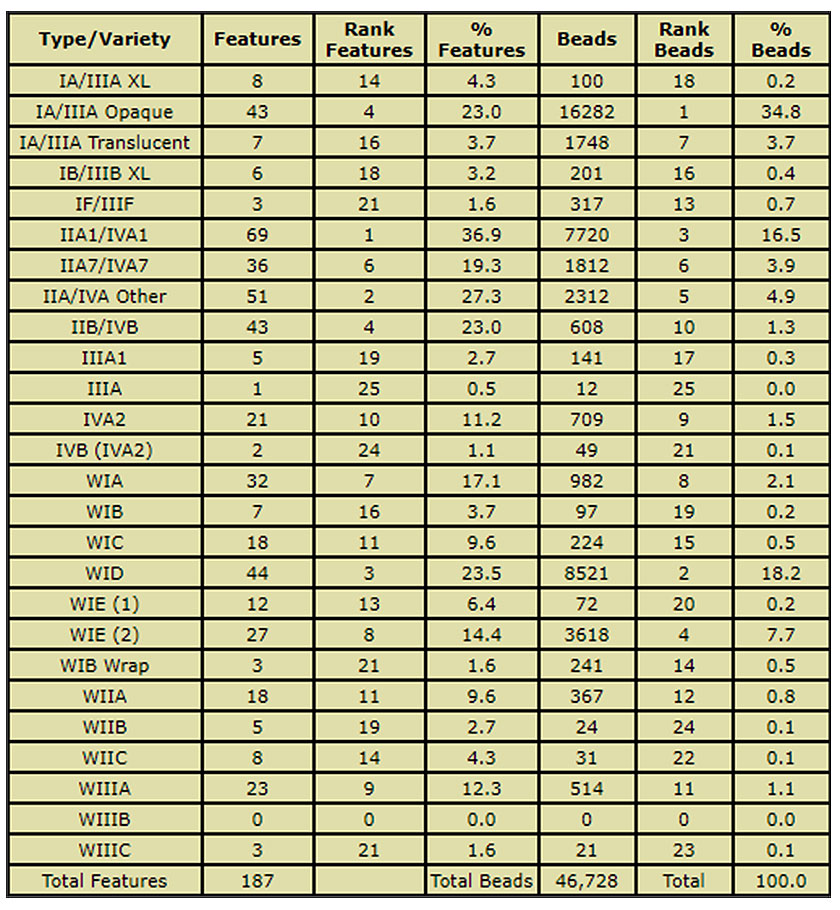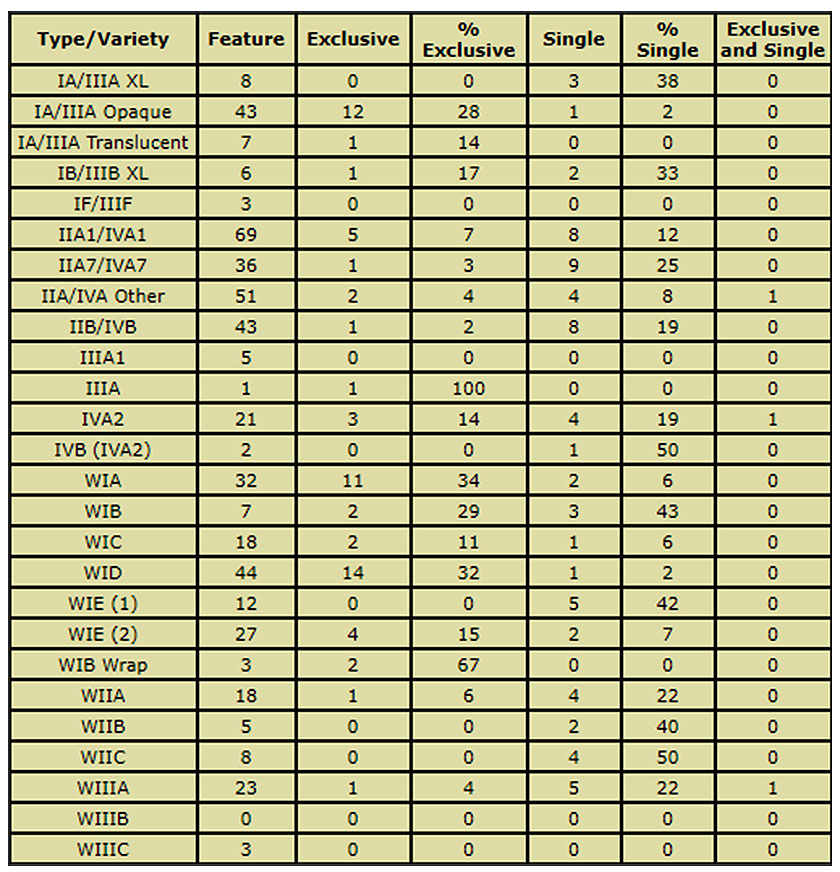
The Glass Bead Database
The database includes 187 features, which contained medium, large, very large or extra large glass beads. The glass bead fields were queried and sorted to determine a number of database attributes - shown on Table 2. Note that for each glass bead field there are corresponding columns in the table for the number of features, the numerical rank of feature, the percentage feature occurrence, the number of beads, the numerical rank of the number of beads and the percentage bead occurrence by number.
Table 2 Glass Bead Features/Numbers
As an example, the bead type IA/IIIA XL occurred in eight features (of the 187) and ranks 14th in the number of features compared to the 26 bead fields. The eight features represent 4.3% of the total features. IA/IIIA XL occurred as 100 specimens, which ranks 18th among the 26 bead categories, based on a population of 46,728 beads with at least a medium size.
Note that 26 glass bead features that were recovered by archaeologists were not included in the feature count or the study as the beads were not available for examination. The author spent a considerable amount of time making assumptions regarding the sizes of the beads and attempting to fit them into the typology. The Chickasaw repatriated these beads.
On Table 2 IIA1/IVA1 leads the % feature occurrence at 36.9%, while making up 16.5% of the bead population. The IA/IIIA Opaque leads the bead population % at 34.8, and is represented in 23.0% of the features.
The largest population of beads is ranked, beginning with the highest: IA/IIIA Opaque, WID, IIA1/IVA1, WIE (2), IIA/IVA Other and IIA7/IVA7. These top six ranking fields constitute 86% of the database bead population, which leaves the remaining 20 fields representing 14%. Figure 3 provides the percentage of total bead database population that each glass bead field represents graphically.
Figure 3 Bead Population
Note that beads with populations less than 2 % are not graphically evident. It is too early to draw conclusions about the Chickasaw bead population from Figure 1. However, we may make some comparisons to Tunica. Note that the two highest Chickasaw population beads, IA/IIIA Opaque and WID, were barely represented at Tunica, which Brain (Brain 1981 1) associated to 1760. Recall at Tunica that IVA1 dominated the bead population at 80%. In this database, our conjoined IIA1/IVA1 varieties make up 16.5% of the population. Also, remember the Chickasaw database excluded the small and very small sized beads that were included at Tunica.
This paper is less concerned about numerical bead population than how the bead types/varieties relate to each other within the features. Figure 4 demonstrates the number of features for each bead type/variety.
Figure 4 Bead Feature Representation
IIA1/IVA1, IIA/IVA Other, WID, IA/IIIA Opaque and IIB/IVB represent the highest feature occurrences. It should be apparent that the percentages exhibited on Figure 4 exceed 100% as the beads are associated with each feature, which may contain many bead types/varieties.
Table 3 provides insight into the composition of the features for each glass bead field.
Table 3 Glass Bead Feature Analysis
First, Table 3 repeats the number of features from Table 2. Next on Table 3, the number of exclusive features is indicated. An exclusive feature is one that contained one bead type/variety exclusively. For example, WIA occurred in 32 features; eleven of those features contained exclusively WIA bead type. Note that there are 64 exclusive bead features among the 187 glass bead features, or 34% exclusives. As we proceed with the bead sequencing, these exclusive features will be examined more closely. The bead type/varieties that occurred both in a large number of features and exhibited a high number of exclusives are WIA, WID and IA/IIIA Opaque.
Single bead features are also noted on Table 3. Single bead features indicate that a single specimen of a bead type/variety was found within a feature. That feature may have included other bead types/varieties but only a single specimen of the bead field noted. The significance of the single bead occurrence may indicate that a bead was used as an heirloom. IIA1/IVA1, IIA7/IVA7 and IIB/IVB exhibited the highest number of single bead features.
The last column on Table 3 identifies how many of the bead types/varieties occurred as both exclusives and singles, i.e. did any of the features contain only one bead. It is interesting to note that few features had single, exclusive beads.
Note that bead type WIIIB while occurring within the collections did not make the database. This bead type will be eliminated from further discussion.



